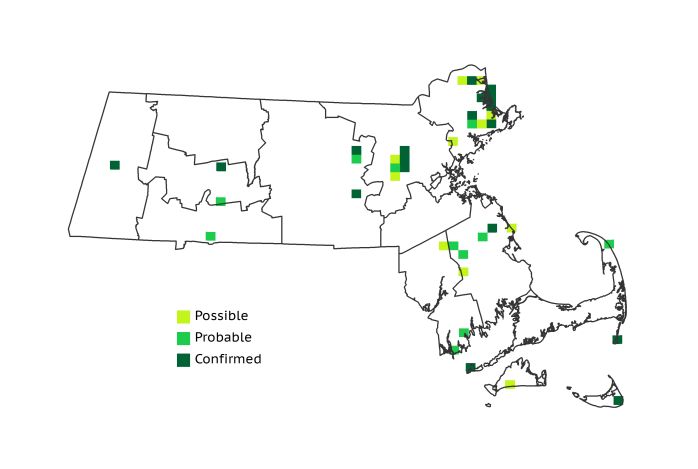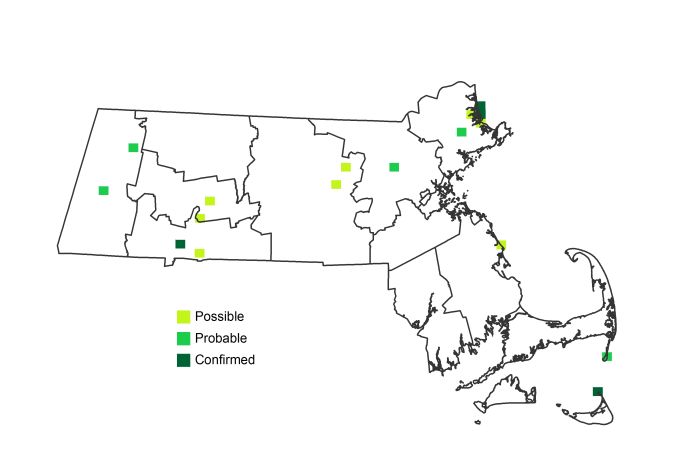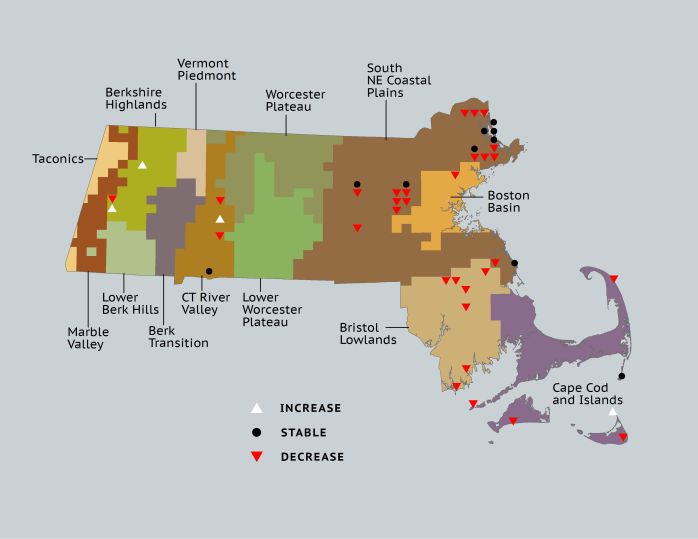Find a Bird
Blue-winged Teal
Anas discors

Very local and strongly declining
Conservation action urgent
”When advancing against a stiff breeze, they alternately show their upper and lower surfaces, and you are struck by the vivid steel-blue of their mantle, which resembles the dancing light of a piece of glass suddenly reflected on a distant object.” – John James Audubon, Birds of America
Small in stature but swift of wing, the Blue-winged Teal is a “prairie pothole” duck whose breeding distribution lies mostly to our west. Unlike the Gadwall, however, the Blue-winged Teal seems to have found its way to Massachusetts without human assistance. While Massachusetts has always been at the periphery of its breeding range, the Blue-winged Teal has long been a fairly regular (if local) breeder across the Bay State. Unfortunately, it now seems that the first signs of potential trouble in this small population are beginning to emerge.
Historic Status
The jury is out on the historic status of Blue-winged Teal as a breeder in Massachusetts. Old-time gunners interviewed at the beginning of the twentieth century remembered the species as being prevalent in the state, especially in the fall. No chronicler at the time was prepared to say anything more than that the bird “probably” nested in Massachusetts at one time save for Joel Asaph Allen, who in the late nineteenth century called them “formerly doubtless a summer resident” (Allen 1878). At the same time, the bird was definitely on the decline. In one of Edward Howe Forbush's famous unstructured polls of correspondents from around the state, 8 respondents claimed the bird was increasing in Massachusetts, while 100 claimed the opposite. The mid-twentieth century creation of National Wildlife Refuge impoundments at Parker River National Wildlife Refuge in Essex County, Monomoy National Wildlife Refuge on Cape Cod, and at locations along the Sudbury and Concord Rivers in Middlesex County offered new nesting habitat for potential breeders.
Atlas 1 Distribution
Though not widespread, Blue-winged Teal had a larger breeding footprint during Atlas 1 than other peripheral nesting duck species like Gadwalls and Northern Shovelers. Teal were thinly distributed in the western part of the state, appearing in only a single Berkshire Highlands block and 3 Connecticut River Valley blocks. The Coastal Plains had just over half of all occupied blocks in the state, with a considerable concentration in eastern Essex County. There were several blocks with Possible and Probable breeding activity in the Bristol/Narragansett Lowlands, but no breeding was Confirmed in this region. Conversely, the Cape and Islands had a handful of Confirmations from Monomoy, the Elizabeth Islands, and Nantucket, with a few other occupied blocks as well.
Atlas 2 Distribution and Change
Atlas 2 detected a decline of Blue-wings in all areas where they were found during Atlas 1. Of particular note were the losses in eastern Massachusetts: Blue-winged Teal vanished from 15 blocks in the Coastal Plains with no new colonizations, and the species was completely gone from the Bristol/Narragansett Lowlands. Massachusetts supported small but persistent numbers of Blue-winged Teal for 100 years or more, but patterns of decline similar to those found in the Bay State were also described in Ontario and New York second Breeding Bird Atlases. Continent-wide federal surveys of trends in waterfowl populations do not reflect declines in long-term averages for Blue-wings, but these estimates are based on surveys in the heart of their breeding range. Along the periphery of their range, and using atlas methods, the trends for this species as a breeding bird suggest declines over many parts of the eastern landscape.
Atlas 1 Map

Atlas 2 Map

Atlas Change Map

Ecoregion Data
Atlas 1 | Atlas 2 | Change | ||||||
Ecoregion | # Blocks | % Blocks | % of Range | # Blocks | % Blocks | % of Range | Change in # Blocks | Change in % Blocks |
Taconic Mountains | 0 | 0.0 | 0.0 | 0 | 0.0 | 0.0 | 0 | 0.0 |
Marble Valleys/Housatonic Valley | 0 | 0.0 | 0.0 | 0 | 0.0 | 0.0 | 0 | 0.0 |
Berkshire Highlands | 1 | 1.8 | 2.5 | 2 | 3.6 | 11.8 | 1 | 1.9 |
Lower Berkshire Hills | 0 | 0.0 | 0.0 | 0 | 0.0 | 0.0 | 0 | 0.0 |
Vermont Piedmont | 0 | 0.0 | 0.0 | 0 | 0.0 | 0.0 | 0 | 0.0 |
Berkshire Transition | 0 | 0.0 | 0.0 | 0 | 0.0 | 0.0 | 0 | 0.0 |
Connecticut River Valley | 3 | 5.4 | 7.5 | 4 | 6.2 | 23.5 | -1 | -2.1 |
Worcester Plateau | 0 | 0.0 | 0.0 | 0 | 0.0 | 0.0 | 0 | 0.0 |
Lower Worcester Plateau | 0 | 0.0 | 0.0 | 0 | 0.0 | 0.0 | 0 | 0.0 |
S. New England Coastal Plains and Hills | 23 | 8.5 | 57.5 | 9 | 3.2 | 52.9 | -15 | -6.6 |
Boston Basin | 1 | 1.8 | 2.5 | 0 | 0.0 | 0.0 | -1 | -1.8 |
Bristol and Narragansett Lowlands | 7 | 6.6 | 17.5 | 0 | 0.0 | 0.0 | -7 | -6.9 |
Cape Cod and Islands | 5 | 3.7 | 12.5 | 2 | 1.4 | 11.8 | -3 | -2.5 |
Statewide Total | 40 | 4.1 | 100.0 | 17 | 1.6 | 100.0 | -26 | -3.1 |
Notes
Unlike most of our other waterfowl, Blue-winged Teal are long-distance migrants, and they spend their winters in the sunny Caribbean. This factor of natural history seems to have placed our Blue-winged Teal in a precarious position; in fact, a recent study found that 26% of all Blue-winged Teal hatched in the northeastern US are shot in the Caribbean – a region that accounts for only 6% of the total annual harvest of the species (Szymanski & Dubovsky 2009). This disproportionate hunting pressure may explain the substantial declines shown by the Atlas, which are supported by a significant decreasing Breeding Bird Survey trend in the Eastern US overall.



